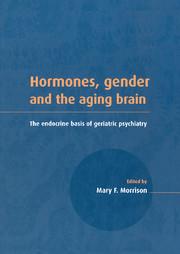Book contents
- Frontmatter
- Contents
- List of contributors
- Preface
- Acknowledgments
- Part I Overview
- Part II Hormones and mental health in the elderly
- 3 The hypothalamic–pituitary–adrenal axis in aging: preclinical and clinical studies
- 4 The hypothalamic–pituitary–thyroid axis
- 5 Estrogen and depression in aging women
- 6 The role of testosterone in male depression
- 7 Dehydroepiandrosterone in aging and mental health
- 8 Sex hormones, cognition, and dementia in the elderly
- 9 Effects of estrogen on basal forebrain cholinergic neurons and cognition: implications for brain aging and dementia in women
- 10 Gender and schizophrenia
- 11 Sex steroids and anxiety disorders
- 12 Gender and hormonal factors in pain and pain inhibition
- Part III Effects of hormones and behavior on immune function
- Part IV Hormones and gender differences in psychotropic drug metabolism
- Index
3 - The hypothalamic–pituitary–adrenal axis in aging: preclinical and clinical studies
from Part II - Hormones and mental health in the elderly
Published online by Cambridge University Press: 18 September 2009
- Frontmatter
- Contents
- List of contributors
- Preface
- Acknowledgments
- Part I Overview
- Part II Hormones and mental health in the elderly
- 3 The hypothalamic–pituitary–adrenal axis in aging: preclinical and clinical studies
- 4 The hypothalamic–pituitary–thyroid axis
- 5 Estrogen and depression in aging women
- 6 The role of testosterone in male depression
- 7 Dehydroepiandrosterone in aging and mental health
- 8 Sex hormones, cognition, and dementia in the elderly
- 9 Effects of estrogen on basal forebrain cholinergic neurons and cognition: implications for brain aging and dementia in women
- 10 Gender and schizophrenia
- 11 Sex steroids and anxiety disorders
- 12 Gender and hormonal factors in pain and pain inhibition
- Part III Effects of hormones and behavior on immune function
- Part IV Hormones and gender differences in psychotropic drug metabolism
- Index
Summary
Introduction
All organisms are exposed to stimuli construed as stressors and all organisms mount a characteristic physiologic response to stress to maintain homeostasis (Herman et al., 1996). Many physical illnesses can be linked to life stress, particularly in aged individuals (McEwen & Stellar, 1993; Clauw & Chrousos, 1997; Katz, 1996). Impairments in the physiological responses to stress have particularly been associated with immune, endocrine, neurological, and psychiatric disorders. Examples of neuropsychiatric disorders, which are associated with dysregulation of the stress response, include depression, post-traumatic stress disorder, and neurodegenerative disorders (Kathol et al., 1989; Charney et al., 1993; McEwen, 1992, Landfield & Eldridge, 1991; Sapolsky et al., 1986; Landfield et al., 1992).
Activation of physiologic stress responses involve the sympathetic nervous system and the hypothalamic–pituitary–adrenal (HPA) axis. The HPA axis is the best characterized component of the physiologic stress response. In aging, this stress component undergoes significant changes. As mentioned, changes are associated with neurologic and psychiatric disorders in late life, and it has been hypothesized that these changes are related to the pathogenesis of some of these disorders. The purpose of this chapter is to discuss the alterations in the HPA axis which occur with normal aging and also to relate these changes within the context of disorders of aging. We will initially discuss the physiology of the HPA axis. This discussion will be followed by a discussion of animal and human studies which have examined the HPA axis in normal aging and disease states in late life.
- Type
- Chapter
- Information
- Hormones, Gender and the Aging BrainThe Endocrine Basis of Geriatric Psychiatry, pp. 37 - 52Publisher: Cambridge University PressPrint publication year: 2000



